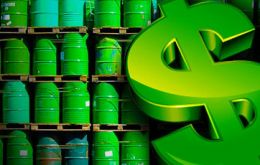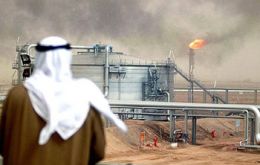MercoPress. South Atlantic News Agency
Tag: Saudi Arabia oil
-
Monday, September 16th 2019 - 08:38 UTC
Trump releases oil from strategic reserves following drone attacks on Saudi oil fields

President Donald Trump announced on Sunday evening that he has authorized the release of oil from the Strategic Petroleum Reserve following attacks on Saudi Arabian oil fields and refineries.
-
Thursday, October 4th 2018 - 07:04 UTC
Oil hits new high ahead of US sanctions on Iran supply, and despite Russia and Saudi higher production

Brent crude rose nearly 2% after hitting a four-year high on Wednesday as the market focused on upcoming U.S. sanctions on Iran while shrugging off the year’s largest weekly build in U.S. crude stockpiles and reports of higher Saudi Arabian and Russian production.
-
Sunday, March 4th 2018 - 15:58 UTC
Oil Market Fears: War, Default And Nuclear Weapons

The U.S. is one of the few areas of the world in which there is an energy investment boom underway, a development that could smooth out the uncertainties of geopolitical events around the world. At the same time, outside of the U.S., there is a deterioration of stability in many oil-producing regions, aggravating risks for both oil companies and the oil market, according to a new report.
-
Wednesday, November 8th 2017 - 10:50 UTC
Oil markets settle lower, but prospects are in place for prices to continue climbing

Oil settled lower on Tuesday after rising to the highest since July 2015 the previous day, while tension flared between Saudi Arabia and Iran, and the Saudi crown prince tightened his grip on power.
-
Friday, September 30th 2016 - 15:00 UTC
Where will oil prices go after Algiers?

Saudi Arabia and Iran may yet come to terms on some sort of production arrangement, but the outcome of the negotiations in Algeria this week may not do much to rescue oil prices. Following the media spectacle, the oil markets may have to shift their attention back to the supply and demand fundamentals, which are not reassuring
-
Wednesday, September 28th 2016 - 12:26 UTC
Iran-Saudi Arabia can't agree on limiting oil supply: “maybe in November”

Iran rejected on Tuesday an offer from Saudi Arabia to limit its oil output in exchange for Riyadh cutting supply, dashing market hopes the two major OPEC producers would find a compromise this week to help ease a global glut of crude.
-
Monday, January 18th 2016 - 05:34 UTC
War between Saudi Arabia and Iran could send oil prices to $250

By James Stafford of Oilprice.com - The rift between Saudi Arabia and Iran has quickly ballooned into the worst conflict in decades between the two countries. The back-and-forth escalation quickly turned the simmering tension into an overt struggle for power in the Middle East
-
Monday, August 10th 2015 - 06:46 UTC
Global oil supply more fragile than you think

Many oil companies had trimmed their budgets heading into 2015 to deal with lower oil prices. But the rebound in April and May to $60 per barrel from the mid-$40s suggested that the severe drop was merely temporary.
-
Thursday, May 14th 2015 - 08:17 UTC
Saudi Arabia continues to turn screws on U.S. Shale

Saudi Arabia continues to ratchet up production, taking market share away from U.S. shale producers. According to OPEC's latest monthly oil report, Saudi Arabia boosted its oil output to 10.31 million barrels per day in April, a slight increase over the previous month's total of 10.29 million barrels.
-
Saturday, April 25th 2015 - 06:33 UTC
Oil price war may benefit both US Shale and Saudi Arabia

Even as financial commentators on CNBC are starting to come around to the idea of a bottom in oil prices, the key question for US oil producers remains one of timing. How long will the oil price slump last? Is this a relatively short term event like 2008, or a longer term slump like the one in the mid 1980’s?
